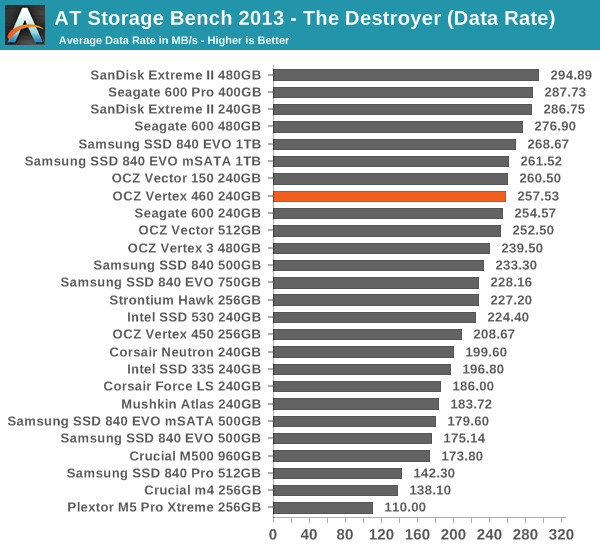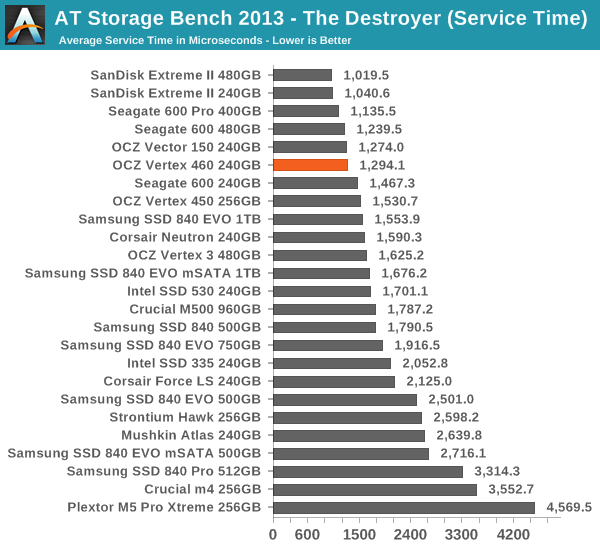OCZ Vertex 460 (240GB) Review
by Kristian Vättö on January 22, 2014 9:00 AM EST- Posted in
- Storage
- SSDs
- OCZ
- Indilinx
- Vertex 460
AnandTech Storage Bench 2013
When Anand built the AnandTech Heavy and Light Storage Bench suites in 2011 he did so because we did not have any good tools at the time that would begin to stress a drive's garbage collection routines. Once all blocks have a sufficient number of used pages, all further writes will inevitably trigger some sort of garbage collection/block recycling algorithm. Our Heavy 2011 test in particular was designed to do just this. By hitting the test SSD with a large enough and write intensive enough workload, we could ensure that some amount of GC would happen.
There were a couple of issues with our 2011 tests that we've been wanting to rectify however. First off, all of our 2011 tests were built using Windows 7 x64 pre-SP1, which meant there were potentially some 4K alignment issues that wouldn't exist had we built the trace on a system with SP1. This didn't really impact most SSDs but it proved to be a problem with some hard drives. Secondly, and more recently, we've shifted focus from simply triggering GC routines to really looking at worst-case scenario performance after prolonged random IO.
For years we'd felt the negative impacts of inconsistent IO performance with all SSDs, but until the S3700 showed up we didn't think to actually measure and visualize IO consistency. The problem with our IO consistency tests is that they are very focused on 4KB random writes at high queue depths and full LBA spans–not exactly a real world client usage model. The aspects of SSD architecture that those tests stress however are very important, and none of our existing tests were doing a good job of quantifying that.
We needed an updated heavy test, one that dealt with an even larger set of data and one that somehow incorporated IO consistency into its metrics. We think we have that test. The new benchmark doesn't even have a name, we've just been calling it The Destroyer (although AnandTech Storage Bench 2013 is likely a better fit for PR reasons).
Everything about this new test is bigger and better. The test platform moves to Windows 8 Pro x64. The workload is far more realistic. Just as before, this is an application trace based test–we record all IO requests made to a test system, then play them back on the drive we're measuring and run statistical analysis on the drive's responses.
Imitating most modern benchmarks Anand crafted the Destroyer out of a series of scenarios. For this benchmark we focused heavily on Photo editing, Gaming, Virtualization, General Productivity, Video Playback and Application Development. Rough descriptions of the various scenarios are in the table below:
| AnandTech Storage Bench 2013 Preview - The Destroyer | ||||||||||||
| Workload | Description | Applications Used | ||||||||||
| Photo Sync/Editing | Import images, edit, export | Adobe Photoshop CS6, Adobe Lightroom 4, Dropbox | ||||||||||
| Gaming | Download/install games, play games | Steam, Deus Ex, Skyrim, Starcraft 2, BioShock Infinite | ||||||||||
| Virtualization | Run/manage VM, use general apps inside VM | VirtualBox | ||||||||||
| General Productivity | Browse the web, manage local email, copy files, encrypt/decrypt files, backup system, download content, virus/malware scan | Chrome, IE10, Outlook, Windows 8, AxCrypt, uTorrent, AdAware | ||||||||||
| Video Playback | Copy and watch movies | Windows 8 | ||||||||||
| Application Development | Compile projects, check out code, download code samples | Visual Studio 2012 | ||||||||||
While some tasks remained independent, many were stitched together (e.g. system backups would take place while other scenarios were taking place). The overall stats give some justification to what we've been calling this test internally:
| AnandTech Storage Bench 2013 Preview - The Destroyer, Specs | |||||||||||||
| The Destroyer (2013) | Heavy 2011 | ||||||||||||
| Reads | 38.83 million | 2.17 million | |||||||||||
| Writes | 10.98 million | 1.78 million | |||||||||||
| Total IO Operations | 49.8 million | 3.99 million | |||||||||||
| Total GB Read | 1583.02 GB | 48.63 GB | |||||||||||
| Total GB Written | 875.62 GB | 106.32 GB | |||||||||||
| Average Queue Depth | ~5.5 | ~4.6 | |||||||||||
| Focus | Worst-case multitasking, IO consistency | Peak IO, basic GC routines | |||||||||||
SSDs have grown in their performance abilities over the years, so we wanted a new test that could really push high queue depths at times. The average queue depth is still realistic for a client workload, but the Destroyer has some very demanding peaks. When we first introduced the Heavy 2011 test, some drives would take multiple hours to complete it; today most high performance SSDs can finish the test in under 90 minutes. The Destroyer? So far the fastest we've seen it go is 10 hours. Most high performance SSDs we've tested seem to need around 12–13 hours per run, with mainstream drives taking closer to 24 hours. The read/write balance is also a lot more realistic than in the Heavy 2011 test. Back in 2011 we just needed something that had a ton of writes so we could start separating the good from the bad. Now that the drives have matured, we felt a test that was a bit more balanced would be a better idea.
Despite the balance recalibration, there is just a ton of data moving around in this test. Ultimately the sheer volume of data here and the fact that there's a good amount of random IO courtesy of all of the multitasking (e.g. background VM work, background photo exports/syncs, etc...) makes the Destroyer do a far better job of giving credit for performance consistency than the old Heavy 2011 test. Both tests are valid; they just stress/showcase different things. As the days of begging for better random IO performance and basic GC intelligence are over, we wanted a test that would give us a bit more of what we're interested in these days. As Anand mentioned in the S3700 review, having good worst-case IO performance and consistency matters just as much to client users as it does to enterprise users.
We are reporting two primary metrics with the Destroyer: average data rate in MB/s and average service time in microseconds. The former gives you an idea of the throughput of the drive during the time that it was running the Destroyer workload. This can be a very good indication of overall performance. What average data rate doesn't do a good job of is taking into account response time of very bursty (read: high queue depth) IO. By reporting average service time we heavily weigh latency for queued IOs. You'll note that this is a metric we've been reporting in our enterprise benchmarks for a while now. With the client tests maturing, the time was right for a little convergence.

The Vertex 460 is only a hair slower than the Vector 150 in our Storage Bench 2013. The difference actually falls into the margin of error, so it seems that in spite of the lower clock speed, the performance is essentially the same.











69 Comments
View All Comments
melgross - Wednesday, January 22, 2014 - link
This site is obsessed with this company. There are so many manufacturers, and so many drives, but they keep coming back to OCZ.Kristian Vättö - Wednesday, January 22, 2014 - link
Is there a manufacturer or drive we've missed? We don't favour any OEM over another and if there's a new product we'll review it.However, a lot depends on the company's PR. OCZ has always been good at this as they approach us and provide samples under NDA prior to the launch, so the review process is smooth for us. Some companies are fairly poor at this as we always have to approach the OEM after the launch to get a sample at all.
GrizzledYoungMan - Wednesday, January 22, 2014 - link
Since you asked, there are some SSD-related reviews I'd love to see from Anandtech:1. The Sandisk X210. It promises Extreme II performance with many of the reliability features of an enterprise drive and excellent pricing.
2. 'Hybrid' RAID 5 or RAID 6 configurations, with caching software such as LSI's Cachecade 2.0 or Adaptec's I-can't-remember-right-now. I've been specc'ing out such a system and found it startling how little in-depth, useful information there is out there about what sort of SSDs are appropriate (and why) and what configurations yield good price/performance outcomes.
3. Along those lines, I'd really like to see how enterprise SSDs you've tested like the Intel DC S3500 perform in your client testing environment. It feels like your enterprise SSD testing is woefully truncated on the false assumption that no one would use enterprise SSDs in a client/workstation setting. Testing those drives more thoroughly would seem to be a much better use of your time than testing the Nth variation of whatever OCZ drive came out this week.
I hope you find this comment helpful, it's intended as constructive criticism. Still love the site!
Kristian Vättö - Wednesday, January 22, 2014 - link
This is definitely helpful. In the end we do this for you, our readers, not four ourselves or manufacturers :)1 and 3 should definitely be possible and 2 very likely too (as long as LSI/Adaptec can deliver us the samples). I'll do my best!
GrizzledYoungMan - Wednesday, January 22, 2014 - link
Awesome! Looking forward to reading those reviews.A recommendation regarding which LSI controller to choose: go for the 9271-8i. At this point, it's the natural choice for most new system builders because it offers better performance (and Fastpath enabled by default) as the 9266 or 9261 for roughly the same price.
Also, if LSI gives you any trouble about providing samples, just tell 'em that some random guy from the internet who calls himself grizzledyoungman wants to see that review. Should do the trick.
romrunning - Thursday, January 23, 2014 - link
1) I also would like to see more tests of SSDs in RAID arrays (RAID-5/6/10 - not just 0/1).2) I would love to see some enterprise controllers tested like the Adaptec ASR-72405 and ASR-8885.
3) In addition to that, let's test more enterprise SSDs (like HGST's SSD800MM and the DC3700).
4) For SMBs who want to build a fast server with awesome I/O, it would be good to see how these SSDs perform in a database server or as a virtual host server.
lever_age - Wednesday, January 22, 2014 - link
Yeah, when products don't get reviewed, it's usually time to start bugging the company PR teams. The bigger and reputable sites have enough work already reviewing the stuff that gets sent to them by the brands that do have their acts together (and want things reviewed).JDG1980 - Wednesday, January 22, 2014 - link
I don't think it's good practice to rely upon free review samples. How do you know the company isn't cherry-picking? I believe it would be best to do what Consumer Reports does with all the items it tests: buy anonymously off-the-shelf.blanarahul - Wednesday, January 22, 2014 - link
Cherry picking MLC SSDs affects performance? That's new. Or maybe, you are wrong.chrnochime - Wednesday, January 22, 2014 - link
How is cherry picking NOT useful for better test results? That's what the definition of cherry picking is. Sounds like you either are ignorant of that fact or are defending OCZ for whatever reason.